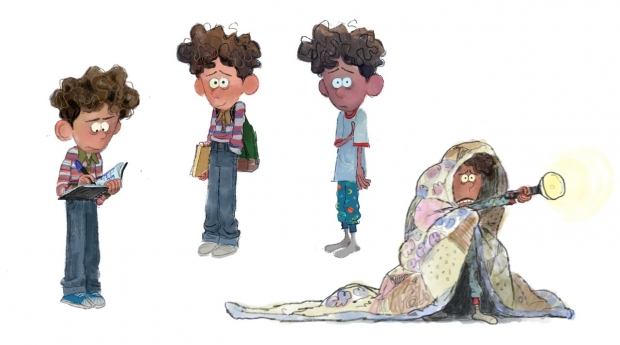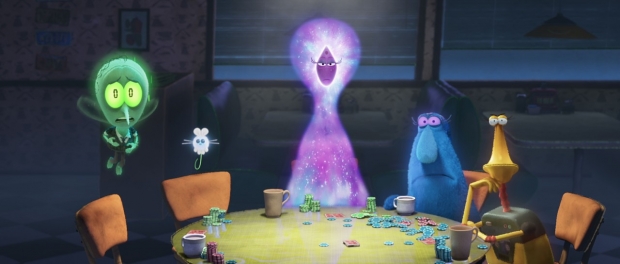The production designer and art director approached the challenging, ‘scrappy indie project’ by honoring the hand-painted, watercolor feel of Emma Yarlett’s original book; written by Oscar-winner Charlie Kaufman, the DreamWorks’ and Mikros Animation film debuts on Netflix February 2, 2024.
Many filmmakers talk about how their production team put their “heart and soul” into a film and its visuals. But in the case of Orion and the Dark, the sentiment isn’t mere expression.
“One of our crew members, Meghan Noyes, passed away during production after losing her battle with leukemia,” shares Tim Lamb, production designer on Orion and the Dark. “And in one of the last shots, in a starry sky, we put her name in a constellation.”
Produced by DreamWorks Animation and Mikros Animation, Orion and the Dark follows elementary-age Orion, who seems like the average shy, unassuming kid harboring a secret crush. But underneath his seemingly normal exterior, Orion is a ball of adolescent anxiety, completely consumed by irrational fears of bees, dogs, the ocean, murderous gutter clowns, falling off a cliff, and even getting cancer. But of all his fears, the thing he’s the most afraid of is what he confronts on a nightly basis: the dark. So, when the literal embodiment of his worst fear, Dark, pays a visit, Orion gets whisked away on a roller coaster ride around the world to prove there is nothing to be afraid of during the night. As the unlikely pair grow closer, Orion must decide if he can learn to accept the unknown -- to stop letting fear control his life and finally embrace the joy of living.
The film, Sean Charmatz’s directorial debut, releases on Netflix Friday, February 2. It’s written by Oscar winner Charlie Kaufman (Anomalisa, Eternal Sunshine of the Spotless Mind), based on the children's book of the same name by Emma Yarlett.
“I think the fact that Orion is so young and has all these fears brings attention to the fact that kids are really complex, and they have really complex internal dialogue,” notes art director Christine Bian. “I remember having those fears as a kid and when we all grow up and become adults, we forget about that internal dialogue we had as kids.”
That is, until we lose a friend. Perhaps more unnerving than even gutter clowns is the impending unknown that comes after death. And while it’s one thing to make a movie about a kid facing his worst fears - both philosophical and less so - it’s another for filmmakers to come face to face with those fears themselves while making such a movie.
“We had a couple of really tough tragedies throughout production,” says Lamb. “Meghan was one, but there were a few others. And it was amidst an already chaotic production. There were a few moments where we all took a step back and realized there were bigger things to be stressed out about or worried about. Orion’s existential fears about the afterlife and death are something we all struggle with. And I think that's what makes the story so beautiful, and so relatable. So, as taxing as production can be, life is often more so. It was important to have that all in perspective.” The film crew also dedicated an “In Loving Memory” end card after the main credits for both Noyes and Noelle McCown, wife of producer Peter McCown, who also passed away during the production.
Having worked as a character designer and art director on animated features like Trolls and Megamind, Lamb was no stranger to eclectic characters and wacky worlds. But when he came onto the team for Orion back in 2020, he knew this would be something really special… and difficult.
“I was fully drawn in by the script,” says Lamb. “I knew that it would present a lot of really interesting creative challenges for us. I knew it'd be fun to design. But the production was small scale. Very small. This meant there wasn't a lot of development time, even though the scope of the story was huge, global even. So, we had to get creative with our limitations just to find solutions within the parameters of the time we were given. And that was a weekly conversation we had, about ways to reduce complexity and figure out how to make this thing happen.”
Orion and the Dark features a wide range of characters - including Dark, his nemesis Light, Sweet Dreams, Insomnia, Quiet, and others - which embody elements and ideas that regularly affect the environments around them. Dark and Light provide the biggest transformation, blanketing the world in a watercolor array of day or night as their wispy forms sweep across cities and countrysides.
It’s a beautiful and, not surprisingly, a massive undertaking.
“Tim, from the get-go, really wanted to honor the hand-painted, watercolor feel of the original book,” says Bian, previously known for her work on Love, Death & Robots. “It was this totally different style than a traditional CG work.”
She continues, “Tim, our VFX supervisor Scott McKee, and I would drop ink from different heights on a ladder to see how it would splash, really paying attention to the edges of the ink splatters. That went all the way into our digimatte department and our compositing department. It took so many people across the board with the same vision to pull it off. It looks simple but it’s definitely not. And, man, was it fun.”
Lamb adds, “We also got to incorporate the blues and greens that Emma used in the book to illustrate nighttime. We always came back to the book for inspiration.”
Both Bian and Lamb describe the production as a “scrappy indie project,” at least for DreamWorks, but that the silver lining, despite the challenge, was that it gave the team more freedom to push the look and feel to be, in Lamb’s words, “a little more aged up than what typically a big studio would do.”
“I think another mantra that I try my best to live off is ‘Create something that you want to see,’ and I think, for Christina and me, we first and foremost wanted to create something that we wanted to watch and something that we felt like was missing in the animation market,” notes Lamb. “That's one of the key reasons we ended up with that type of looser, hand-drawn, not perfect type of look.”
As Lamb and Bian did their practical effect experiments, they would videotape the process and results on their iPhones to send to the various production departments and their animation partners at Mikros in Bangalore, India.
“Parts of the movie are actually that footage from our iPhones and some of it is digitally recreated,” says Lamb. “So, it's a cool mix of media. It's essentially a positive and negative mask of that video that we take of different ink, and it's impossible to control it. It involved taking hundreds of footage clips at the right angle and the right speed, combining, and stitching those two together, and creating a mask for a matte painting or scene, as opposed to, ‘Here’s our reference. Now digitally recreate it using software.’”
While some of DreamWorks animated features employed similar pipelines, where the animation process and technique had already been established, Orion and the Dark used watercolor methods that had never been attempted by the studio before; it required more trial and error than what would have otherwise been attempted by a more typical 3DCG project.
“We were forging into an unknown territory or frontier, if you will,” says Bian. “It was, at times, very stressful, because we didn't know if something was going to work. But it was so much fun to be able to play and explore and take shortcuts that maybe are not necessarily part of a production pipeline.”
The crew was in the dark, so to speak, and the fact that their main element character was a type of Death Eater-style whisp didn’t help.
“It was so challenging to merge the two elements,” says Lamb of the character design and the ink splatters. “We were really flying by the seat of our pants for most of it.”
Then, there was the issue of scale.
“Not only were all our characters so effects-heavy, but main characters like Dark could be as little as a fly and as big as the entire night sky,” explains Bian. “It was a perfect storm. ‘MacGyvering our way to survival’ could have been the motto of the whole production.”
But despite the uncertainty and wave after wave of new challenges, Bian says she felt excited, more than anything else, about working on Orion and the Dark as it was her first time working on a feature film.
“I now get to check this off by bucket list,” she says.
Lamb agrees, “It was a once-in-a-lifetime chance for most of us in animation. And, yes, it was scrappy, but we were lucky to make this movie. We ended up with something that so many creative people put their heart and soul into, and I think we can all be really proud of that.”
In addition to Meghan’s name lovingly placed in the stars by her friends and colleagues at DreamWorks, other personal touches were added into the film’s visuals that Bian and Lamb say viewers should look out for.
“Sean wanted all our sets and locations to feel like they were from the real world and, in Orion’s school for example, there’s construction paper and posters on the wall and those ‘How to Write in Cursive’ signs and like things like that, which would be in a 90s kid’s school,” starts Bian. “The artist who did the initial design for that, Miho Tomimasu, did an incredible job of painting every single poster and there is a caricature of Tim in there as the logo for our version of a Capri Sun.”
Lamb adds, “Another big one I can think of is Dark has a list of people who are afraid of him and most of the list is people from our production team. We had a lot of fun with the visuals on this one.”


















